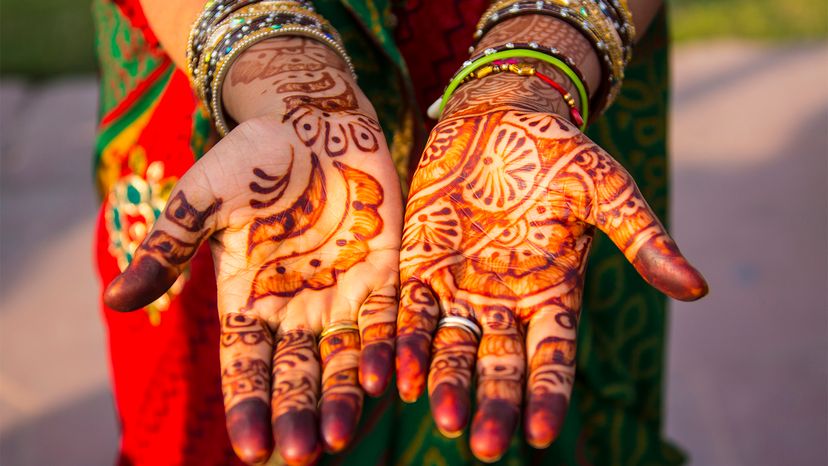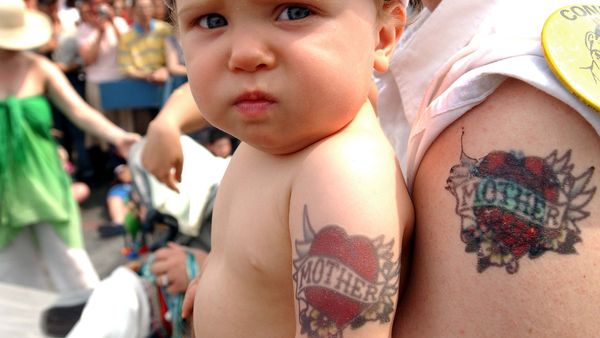Another downside of the globalization of henna, according to Haque, is the widespread appropriation and lack of respect for the sacred tradition. "I think it's important for anyone that is receiving henna to be respectful and do some research on the traditions that are connected with the art," Haque says. "You can start by looking up wedding traditions in the Middle East, North Africa and South Asia. You can also research some religious holidays such as Eid, Diwali, Karva Chauth and Teej. Some hold this art very sacred and it is important to ask your artists the tough questions, so that when people ask you, 'what it means and where it comes from,' you can answer enthusiastically and confidently."
"While henna design is prevalent in South Asia, many communities — Eritrean, Somali, Romani, Moroccan and Iranian to name a few — share a vast rich history of henna design," Bühler-Rose says. "It's important for clients to note that symbolism in many henna designs is sacred. Some communities even consider the substance itself to be sacred. Thus, henna and symbols are used respectfully, sensitively and knowledgeably. For example, placing an image of the deity Gaṇeśa on the feet would be considered disrespectful."
"As the art continues to spread around the world, it is essential to stay educated on the origins and traditions," Haque says. "It's also important not to make a mockery of the art or use it as a costume. Nowadays, people of all backgrounds receive and also apply the art. If you are someone that is applying the art, please be mindful and don't use cultural terms to promote your henna business. Don't call yourself a Guru or change your name just to get more clients."
While the rising popularity of henna has resulted in some distortion and misappropriation of its original significance, many artists are committed to keeping the tradition alive. "I have been artistic my entire life," Assar says. "I often visited India as a child and everything from the architecture to the textiles in fabric really inspired me to pursue Indian art in general. I would get my henna done at any given chance and absolutely loved it. I started doing henna professionally in 1994. I was 14 years old and my very first client was a bride. The rest is history."
For Bühler-Rose, henna is a way to preserve and perpetuate her history. "The use of henna evokes memories of precious quiet moments in childhood, during which henna was brewed and applied," she says. "The symbolism and imagery associated with henna use parallels my own spiritual beliefs and religious practice. Thus, henna design is a harmonious experience for me, one during which I access and use various facets of my identity to be present with, and benefit, people."
For Haque, mehndi is a deeply personal practice that she's been able to share with clients of all cultures. "Growing up in a traditional Pakistani home, henna was applied before religious holidays, special events, weddings, and was also applied as a self-care ritual," she says. "I remember going to Pakistan to stay with my cousins and we would do beautiful designs for each other. I loved the process. My aunties would tell me that it was a good practice of patience and grace, as you need to be mindful as you let the henna dry and set into the skin. As a young girl, I always wanted to be an artist but my immigrant parents weren't always supportive. When it came to mehndi art, they allowed it because it kept me close to my culture and it made my family members happy when I applied it on them. After over 10 years of being a henna artist, it has now become a way for me to showcase my culture and where I come from, to express myself artistically, a way for me to help people mark milestones and bring more intention into their lives."
And while Haque encourages both henna artists and clients to respect the sanctity of the tradition, she also believes a modern and gracious interpretation of the practice is possible. "I also believe in the evolution of the art," she says. "There will be new traditions that will develop over the years, but [it's important] to always honor its roots. Henna is a simple plant, it has become the foundation to major milestones in people's lives all over the world and should be treated with reverence."
FAQs
How long does a henna tattoo typically last?
Henna tattoos usually last one to three weeks, depending on factors like skin type, location of the tattoo, and aftercare.
Can henna tattoos be removed easily?
Henna tattoos are not permanent and will naturally fade over time as the skin exfoliates. However, there are no quick or guaranteed methods to remove them completely.


